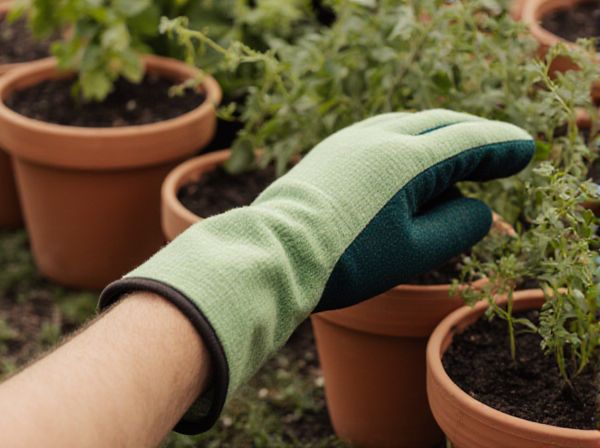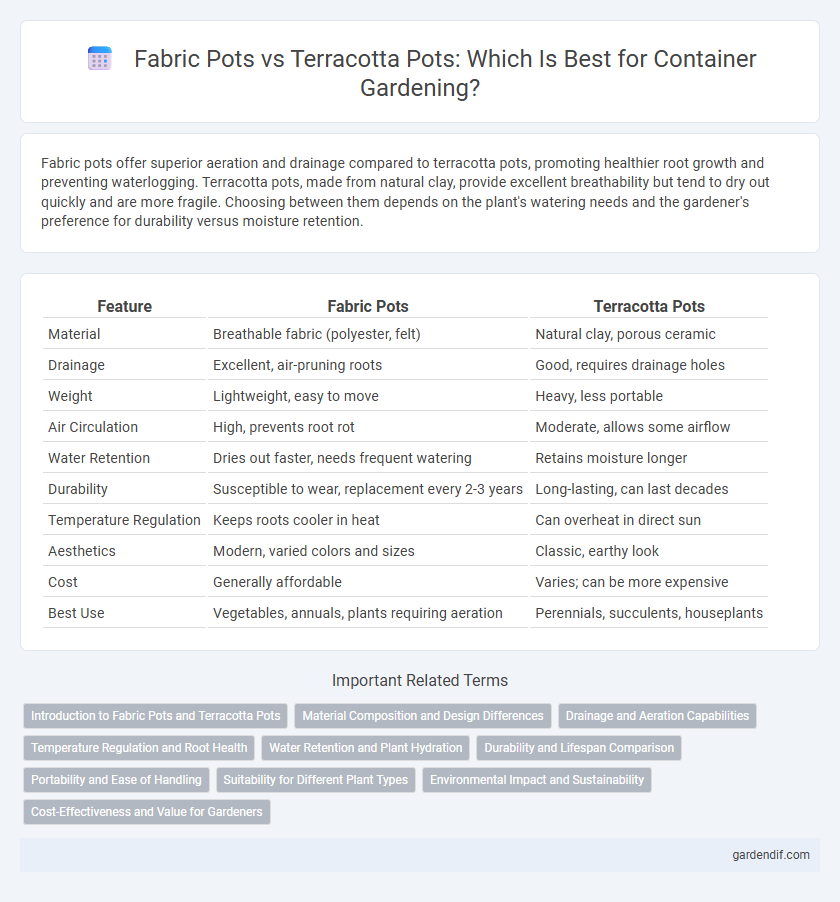
Fabric pots vs terracotta pots Illustration
Fabric pots offer superior aeration and drainage compared to terracotta pots, promoting healthier root growth and preventing waterlogging. Terracotta pots, made from natural clay, provide excellent breathability but tend to dry out quickly and are more fragile. Choosing between them depends on the plant's watering needs and the gardener's preference for durability versus moisture retention.
Table of Comparison
| Feature | Fabric Pots | Terracotta Pots |
|---|---|---|
| Material | Breathable fabric (polyester, felt) | Natural clay, porous ceramic |
| Drainage | Excellent, air-pruning roots | Good, requires drainage holes |
| Weight | Lightweight, easy to move | Heavy, less portable |
| Air Circulation | High, prevents root rot | Moderate, allows some airflow |
| Water Retention | Dries out faster, needs frequent watering | Retains moisture longer |
| Durability | Susceptible to wear, replacement every 2-3 years | Long-lasting, can last decades |
| Temperature Regulation | Keeps roots cooler in heat | Can overheat in direct sun |
| Aesthetics | Modern, varied colors and sizes | Classic, earthy look |
| Cost | Generally affordable | Varies; can be more expensive |
| Best Use | Vegetables, annuals, plants requiring aeration | Perennials, succulents, houseplants |
Introduction to Fabric Pots and Terracotta Pots
Fabric pots are made from breathable, non-woven materials that promote air pruning of roots and improve drainage, enhancing plant health and growth. Terracotta pots, crafted from porous clay, offer natural air circulation and moisture regulation but tend to dry out faster compared to fabric pots. Both containers provide distinct benefits for different gardening needs, with fabric pots excelling in aeration and terracotta pots favored for their classic aesthetic and moisture control.
Material Composition and Design Differences
Fabric pots are made from breathable, non-woven polypropylene or felt materials that allow air pruning of roots and enhanced drainage, promoting healthier root systems. Terracotta pots consist of porous clay that naturally regulates moisture through evaporation, preventing overwatering but requiring more frequent watering. Fabric pots' flexible design adapts to root growth and airflow, while terracotta pots offer rigid structure and traditional aesthetic appeal with their distinctive earthy texture.
Drainage and Aeration Capabilities
Fabric pots offer superior drainage and aeration capabilities compared to terracotta pots, as their breathable material allows excess water to escape and oxygen to reach the roots efficiently. Terracotta pots, while porous and providing moderate aeration, tend to retain more moisture, increasing the risk of root rot in overwatered plants. Enhanced root health and prevention of waterlogging are key benefits of using fabric pots for container gardening.
Temperature Regulation and Root Health
Fabric pots excel in temperature regulation by allowing air to circulate through the breathable material, preventing soil from overheating and promoting cooler root zones. Terracotta pots, while porous, can cause rapid moisture loss and temperature fluctuations that may stress roots. Consistent air pruning in fabric pots enhances root health by preventing circling roots and encouraging a robust root system, unlike the more restrictive environment within terracotta containers.
Water Retention and Plant Hydration
Fabric pots offer superior water retention compared to terracotta pots due to their breathable material, which allows for consistent moisture evaporation and prevents overwatering. Terracotta pots, being porous clay containers, tend to dry out faster, requiring more frequent watering to maintain optimal plant hydration. This consistent moisture regulation in fabric pots promotes healthier root growth and better overall hydration for plants.
Durability and Lifespan Comparison
Fabric pots offer superior durability compared to terracotta pots, as their flexible, tear-resistant materials withstand harsh weather and UV exposure without cracking. Terracotta pots, made from porous clay, are prone to chipping, cracking, and breaking under freeze-thaw cycles, significantly reducing their lifespan. Typically, fabric pots can last several years with proper care, while terracotta pots often require replacement after just one to two seasons in harsh climates.
Portability and Ease of Handling
Fabric pots offer superior portability and ease of handling due to their lightweight, flexible material, making them ideal for frequent relocation and storage. Unlike terracotta pots, which are rigid and heavy, fabric pots can be easily folded and transported without risk of cracking or damage. Their breathable design also simplifies watering and soil aeration, enhancing overall container gardening efficiency.
Suitability for Different Plant Types
Fabric pots offer excellent aeration and drainage, making them ideal for root vegetables, herbs, and plants that prefer well-drained soil. Terracotta pots provide a stable, breathable environment suitable for succulents and cacti due to their ability to wick moisture away from the soil. While fabric pots support vigorous root growth and prevent overwatering, terracotta pots excel in maintaining moderate soil moisture levels for drought-tolerant species.
Environmental Impact and Sustainability
Fabric pots offer superior environmental benefits compared to terracotta pots due to their lightweight, reusable design, and improved plant aeration which reduces water usage. Terracotta pots, although biodegradable and natural, require significant energy for kiln firing and often chip or break, leading to more frequent replacements. Choosing fabric pots supports sustainable gardening by minimizing resource consumption and waste generation.
Cost-Effectiveness and Value for Gardeners
Fabric pots offer superior cost-effectiveness compared to terracotta pots due to their lower purchase price and enhanced durability, reducing the need for frequent replacements. These pots improve plant health with better aeration and drainage, leading to higher crop yields and greater overall value for gardeners. Terracotta pots, while aesthetically appealing, tend to crack in extreme weather, increasing long-term expenses and limiting value.
Fabric pots vs terracotta pots Infographic

 gardendif.com
gardendif.com